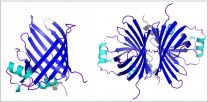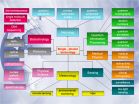(Press-News.org) The researchers headed by Prof Dr Nicole Frankenberg-Dinkel have been the first ones to reveal similarities and differences in the assembly of the light-harvesting machinery of the cryptophyte Guillardia theta compared to cyanobacteria and red algae. The publication of their results in the current issue of "The Journal of Biological Chemistry" is among the two per cent of the publications that were selected as "Paper of the week".
Cryptophytes: Matryoshka dolls of the waters
Unlike traditional eukaryotic cells – i.e. all cells with a nucleus – cryptophyte cells resemble a Russian doll in the form of an alga within an alga. They originated from a eukaryotic cell that engulfed and integrated a red alga. Thus, cryptophytes have acquired the ability to perform photosynthesis. Just like their red algal ancestors, cryptophytes utilise not only the green pigment chlorophyll for harvesting light, but have also the capability to use green light being missed by chlorophyll. This is due to blue or red-tinted proteins – so-called phycobiliproteins. After integrating the red alga, its genome was reduced over time and combined with the host cell's genome. During this process, a number of modifications on genetic, biochemical and physiological levels took place, which facilitated adaptation to new ecological niches. Although the algae maintained the basic principle of photosynthesis, their light-harvesting phycobiliproteins were largely modified and greatly differ from their cyanobacteria and red algae ancestors.
Protected pigment transport in a barrel
In many respects, the way light-harvesting works in Guillardia theta has not yet been understood. RUB researchers have now for the first time gained insight into the complex biosynthesis of cryptophyte phycobiliproteins. "Guillardia theta has obviously combined tried-and-tested and novel synthesis methods and enzymes," says Prof Dr Nicole Frankenberg-Dinkel. The biosynthesis of the magenta-coloured light harvesting pigment phycoerythrobilin is similar to that of cyanobacteria. Docking of pigments on the phycobiliprotein structure, on the other hand, is performed by both known and novel enzymes. Prof Frankenberg-Dinkel's team of researchers succeeded in characterising one of these docking enzymes, GtCPES, in biochemical and structural terms. In collaboration with Dr Raphael Gasper-Schönenbrücher from the work group Protein Crystallography, headed by Prof Dr Eckhard Hofmann, they solved the atomic structure of GtCPES. GtCPES is shaped like a barrel that is sealed only at the bottom end and is open at the top to only let in the magenta-coloured pigment phycoerythrobilin. The barrel's function is to shield the sensitive pigment from external influences while it is being transported to its destination, i.e. to the apo-phycobiliprotein. Thanks to the barrel top's structural properties, the transfer of the pigment is carried out in the correct orientation to a clearly defined spot of the target protein surface.
INFORMATION:
Title page
Overkamp, K. E., Gasper, R., Kock, K., Herrmann, C., Hofmann, E. und Frankenberg-Dinkel, N. (2014) „ Insights into the biosynthesis and assembly of cryptophycean phycobiliproteins" J Biol Chem. 289, 26691-26707, doi: 10.1074/jbc.M114.591131
Green light for clever algae
RUB researchers study extraordinary phycobiliproteins
2014-09-26
ELSE PRESS RELEASES FROM THIS DATE:
Skin pigment renders sun's UV radiation harmless using projectiles
2014-09-26
Researchers at Lund University in Sweden and other institutions have worked out how the pigment of the skin manages to protect the body from the sun's dangerous UV rays. The skin pigment converts the UV radiation into heat through a rapid chemical reaction that shoots protons from the molecules of the pigment.
In a new study, the team from Lund University, working with colleagues in France and Italy, have studied pigment in the skin and its building blocks. Pigment in both skin and hair comprises two different types of melanin: eumelanin and pheomelanin. Eumelanin makes ...
Antibacterial resistance a cause for major concern according to world leading cystic fibrosis expert
2014-09-26
World leading Cystic Fibrosis experts, from Queen's University Belfast, have called for greater research to address the major concern of antibacterial resistance.
Professor Stuart Elborn, an international authority on respiratory medicine, said that more funding and further research are required into antibiotic resistance in order to improve patient outcomes for people with Cystic Fibrosis.
In his paper, Infections in chronic lung diseases 2, which was recently published in The Lancet, Professor Elborn reviews current research into infections in chronic lung diseases. ...
'Multi-spectra glasses' for scanning electron microscopy
2014-09-26
This news release is available in German. The scanning electron microscope is not only used for precisely surveying the surface topology of samples, but also for determining their chemical compositions. This is done by exciting the atoms to fluoresce under irradiation by an electron beam while scanning the sample. This secondary emission provides information about the location and type of element, insofar as the analysis is sufficiently precise. However, the lighter elements of the periodic table such as lithium, beryllium, boron, carbon, and nitrogen emit secondary ...
Protecting the body from itself
2014-09-26
Scientists from A*STAR's Bioprocessing Technology Institute (BTI) have established a clearer relationship between two cells which serve our body's natural defence mechanisms against diseases and infections. Their findings, published in the prestigious journal CELL REPORTS, will help the medical community better understand autoimmunity and could pave the way for treatment of autoimmune diseases.
Natural killer T (NKT) cells and B cells are two of many immune cell types that work in tandem to help the body fight against foreign infectious agents. NKT cells have very potent ...
If trees could talk
2014-09-26
Permafrost thaw drives forest loss in Canada, while drought has killed trees in Panama, southern India and Borneo. In the U.S., in Virginia, over-abundant deer eat trees before they reach maturity, while nitrogen pollution has changed soil chemistry in Canada and Panama. Continents apart, these changes have all been documented by the Smithsonian-led Center for Tropical Forest Science-Forest Global Earth Observatory, CTFS-ForestGEO, which released a new report revealing how forests are changing worldwide.
"With 107 collaborators we've published a major overview of what ...
Neurons see what we tell them to see
2014-09-26
Neurons programmed to fire at specific faces—such as the famously reported "Jennifer Aniston neuron"—may be more in line with the conscious recognition of faces than the actual images seen. Subjects presented with a blended face, such as an amalgamation of Bill Clinton and George W. Bush, had significantly more firing of such face-specific neurons when they recognized the blended or morphed face as one person or the other. Results of the study led by Christof Koch at the Allen Institute for Brain Science, and carried out by neuroscientists Rodrigo Quian Quiroga at the University ...
Suomi NPP satellite data used for mitigating aviation related volcanic hazards
2014-09-26
A joint NOAA/NASA satellite is one of several satellites providing valuable information to aviators about volcanic hazards. An aviation "orange" alert was posted on August 18, 2014, for Bárðarbunga, a stratovolcano located under the Vatnajökull glacier in Iceland, indicating the "volcano shows heightened or escalating unrest with increased potential of eruption."
Much of the information leading to that alert came from satellites including Visible Infrared Imaging Radiometer Suite (VIIRS) instrument on board the National Oceanic and Atmospheric Administration (NOAA)/NASA ...
Mechanized human hands: System designed to improve hand function lost to nerve damage
2014-09-26
CORVALLIS, Ore. – Engineers at Oregon State University have developed and successfully demonstrated the value of a simple pulley mechanism to improve hand function after surgery.
The device, tested in cadaver hands, is one of the first instruments ever created that could improve the transmission of mechanical forces and movement while implanted inside the body.
After continued research, technology such as this may offer new options to people who have lost the use of their hands due to nerve trauma, and ultimately be expanded to improve function of a wide range of damaged ...
Biochemists solve 'address problem' in cells that leads to lethal kidney disease
2014-09-26
Research by UCLA biochemists may lead to a new treatment — or even a cure — for PH1, a rare and potentially deadly genetic kidney disease that afflicts children. Their findings also may provide important insights into treatments for Parkinson's disease, Alzheimer's disease and other degenerative diseases.
Led by Carla Koehler, a professor of chemistry and biochemistry in the UCLA College, the researchers identified a compound called dequalinium chloride, or DECA, that can prevent a metabolic enzyme from going to the wrong location within a cell. Ensuring that the enzyme ...
Single-photon detection, generation, and applications featured in Optical Engineering
2014-09-26
BELLINGHAM, Washington, USA – A new special section on single-photon detection, generation, and applications in Optical Engineering highlights research on technologies with applications in areas as diverse as space exploration and quantum computing, furthering the field by providing more accurate measurement methods and new analysis techniques. The peer-reviewed journal is published by SPIE, the international society for optics and photonics, in print and in the SPIE Digital Library.
The section appears in the August issue, and include nine articles and an editorial outlining ...
LAST 30 PRESS RELEASES:
Multichannel 3D-printed bioactive scaffold combined with siRNA delivery for spinal cord injury recovery
Triaptosis—an emerging paradigm in cancer therapeutics
A new paradigm in spectroscopic sensing: The revolutionary leap of SERS-optical waveguide integration and ai-enabled ultra-sensitive detection
Sweet tooth: How blood sugar migration in diabetes affects cavity development
Lowest suicide rate is in December but some in media still promote holiday-suicide myth
Record-breaking cosmic explosion challenges astronomers’ understanding of gamma-ray bursts
Excessive heat harms young children’s development, study suggests
Quanta Books to publish popular math and physics titles by Terence Tao and David Tong
Philanthropic partnerships fund next-generation instruments for mid-sized telescopes
AI offers ‘roadmap’ to plant genetics
Myosin XI-1: A key molecular target for salt-tolerant crops
Pusan National University study highlights the health hazards of ultrafine particles from small home appliances with electric heating coils and brushed DC motors
Global first: New Indigenous-led research initiative to revitalize legal orders
Transforming acoustic waves with a chip
When climate risk hits home, people listen: Study reveals key to engagement with disaster preparedness messaging
Major breakthrough against diabetes thanks to a microbial molecule that disarms inflammation
Silicon chips on the brain: Researchers announce a new generation of brain-computer interface
Getting rest is the best
Towards sustainable organic synthesis – Mechanochemistry replaces lithium with sodium in organic reactions
Wireless device ‘speaks’ to the brain with light
Greenhouse gases to intensify extreme flooding in the Central Himalayas
New study sheds light on Milky Way's mysterious chemical history
Could altering the daily timing of immunotherapy improve survival in people with cancer?
Weaving secondary battery electrodes with fibers and tying them like ropes for both durability and performance
Using social media may impair children’s attention
Science briefing: An update on GLP-1 drugs for obesity
Lower doses of immunotherapy for skin cancer give better results
Why didn’t the senior citizen cross the road? Slower crossings may help people with reduced mobility
ASH 2025: Study suggests that a virtual program focusing on diet and exercise can help reduce side effects of lymphoma treatment
A sound defense: Noisy pupae puff away potential predators
[Press-News.org] Green light for clever algaeRUB researchers study extraordinary phycobiliproteins









